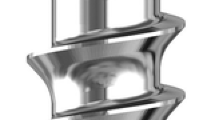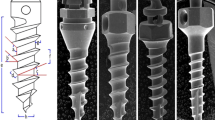Abstract
Objectives
This study aims to investigate orthodontic mini-implant root proximity, placement torque, and damping capacity and to determine whether placement torque and damping capacity (Periotest value (PTV)) are useful indices for the estimation of mini-implant root proximity.
Materials and methods
The root proximity of 143 orthodontic mini-implants (1.6 mm diameter, 8 mm screw thread length) was evaluated in 79 patients (24 males, 55 females; mean age, 22.5 ± 8 years) using cone-beam computed tomography. The placement torque and PTV of each implant were determined using a torque tester and the Periotest, respectively. Variability in these values according to root proximity was evaluated.
Results
PTVs of mini-implants with multiple (two or more) points of contact between the root and implant were significantly larger than those of mini-implants with no root contact in the self-drilling group. Placement torque did not differ significantly according to root proximity. In the self-drilling group, the odds ratio for root contact was 20.82 (P = 0.000) for a PTV >6.
Conclusions
Placement torque could not be used to estimate root proximity. The PTV was significantly affected by root proximity in the self-drilling group.
Clinical relevance
A threshold of PTV >6 could be applied clinically for the estimation of self-drilling mini-implant root proximity.


Similar content being viewed by others
References
Kanomi R (1997) Mini-implant for orthodontic anchorage. J Clin Orthod 31:763–767
Miyawaki S, Koyama I, Inoue M, Mishima K, Sugawara T, Yamamoto T (2003) Factors associated with the stability of titanium screws placed in the posterior region for orthodontic anchorage. Am J Orthod Dentofac Orthop 124:373–378
Sugawara J, Daimaruya T, Umemori M, Nagasaka H, Takahashi I, Kawamura H, Mitani H (2004) Distal movement of mandibular molars in adult patients with the skeletal anchorage system. Am J Orthod Dentofac Orthop 125:130–138
Herman RJ, Currier GF, Miyake A (2006) Mini-implant anchorage for maxillary canine retraction: a pilot study. Am J Orthod Dentofac Orthop 130:228–235
Kim TW, Kim H, Lee SJ (2006) Correction of deep overbite and gummy smile by using a mini-implant with a segmented wire in a growing class II division 2 patient. Am J Orthod Dentofac Orthop 130:676–685
Liou EJ, Pai BC, Lin JC (2004) Do miniscrews remain stationary under orthodontic forces? Am J Orthod Dentofac Orthop 126:42–47
Kuroda S, Yamada K, Deguchi T, Hashimoto T, Kyung HM, Takano-Yamamoto T (2007) Root proximity is a major factor for screw failure in orthodontic anchorage. Am J Orthod Dentofac Orthop 131:S68–S73
Min KI, Kim SC, Kang KH, Cho JH, Lee EH, Chang NY, Chae JM (2012) Root proximity and cortical bone thickness effects on the success rate of orthodontic micro-implants using cone beam computed tomography. Angle Orthod 82:1014–1021
Kim H, Kim TW (2011) Histologic evaluation of root-surface healing after root contact or approximation during placement of mini-implants. Am J Orthod Dentofac Orthop 139:752–760
Estelita CB, Janson G, Chiqueto K, Freitas MR, Henriques JFC, Pinzan A (2006) A three-dimensional radiographic surgical guide for mini-implant placement. J Clin Orthod 40:548–554
Choi HJ, Kim TW, Kim HW (2007) A precise wire guide for positioning interradicular miniscrews. J Clin Orthod 41:258–261
Kim SH, Choi YS, Hwang EH, Chung KR, Kook YA, Nelson G (2007) Surgical positioning of orthodontic mini-implants with guides fabricated on models replicated with cone-beam computed tomography. Am J Orthod Dentofac Orthop 131:S82–S89
Kim SH, Kang SM, Choi YS, Kook YA, Chung KR, John C, Huang JC (2010) Cone-beam computed tomography evaluation of mini-implants after placement: is root proximity a major risk factor for failure? Am J Orthod Dentofac Orthop 138:264–276
Oh JS, Kim SG, Lim SC, Ong JL (2009) A comparative study of two noninvasive techniques to evaluate implant stability: Periotest and Osstell Mentor. Oral Surg Oral Med Oral Pathol Oral Radiol Endod 107:513–518
Nienkemper M, Wilmes B, Panayotidis A, Pauls A, Golubovic V, Schwarz F, Drescher D (2012) Measurement of mini-implant stability using resonance frequency analysis. Angle Orthod. doi:10.2319/043012-354.1
Tachibana R, Motoyoshi M, Shinohara A, Shigeeda T, Shimizu N (2012) Safe placement techniques for self-drilling orthodontic mini-implants. Int J Oral Maxillofac Surg 41:1439–1444
Motoyoshi M, Hirabayashi M, Uemura M, Shimizu N (2006) Recommended placement torque when tightening an orthodontic miniimplant. Clin Oral Implants Res 17:109–114
Motoyoshi M, Yoshida T, Ono A, Shimizu N (2007) Effect of cortical bone thickness and implant placement torque on stability of orthodontic mini-implants. Int J Oral Maxillofac Implants 22:779–784
Zix J, Hug S, Kessler-Liechti G, Mericske-Stern R (2008) Measurement of dental implant stability by resonance frequency analysis and damping capacity assessment: comparison of both techniques in a clinical trial. Int J Oral Maxillofac Implants 3:525–530
Lachmann S, Jäger B, Axmann D, Gomez-Roman G, Groten M, Weber H (2006) Resonance frequency analysis and damping capacity assessment. Part I: an in vitro study on measurement reliability and a method of comparison in the determination of primary dental implant stability. Clin Oral Implants Res 17:75–79
Lachmann S, Laval JY, Jäger B, Axmann D, Gomez-Roman G, Groten M, Weber H (2006) Resonance frequency analysis and damping capacity assessment. Part 2: peri-implant bone loss follow-up. An in vitro study with the Periotest and Osstell instruments. Clin Oral Implants Res 17:80–84
Inaba M (2009) Evaluation of primary stability of inclined orthodontic mini-implants. J Oral Sci 51:347–353
Omasa S, Motoyoshi M, Arai Y, Ejima K, Shimizu N (2012) Low-level laser therapy enhances the stability of orthodontic mini-implants via bone formation related to BMP-2 expression in a rat model. Photomed Laser Surg 30:255–261
Uemura M, Motoyoshi M, Yano S, Sakaguchi M, Igarashi Y, Shimizu N (2012) Orthodontic mini-implant stability and the ratio of pilot hole–implant diameter. Euro J Orthod 34:52–55
Acknowledgments
We thank the staff of the Department of Radiology, Nihon University School of Dentistry, for their assistance with computed tomography. This study was supported by a Grant-in-Aid for Scientific Research (no. 24593111) from the Ministry of Education, Culture, Sports, Science and Technology of Japan.
Conflict of interest
The authors declare that they have no conflicts of interest.
Author information
Authors and Affiliations
Corresponding author
Rights and permissions
About this article
Cite this article
Motoyoshi, M., Uchida, Y., Matsuoka, M. et al. Assessment of damping capacity as an index of root proximity in self-drilling orthodontic mini-implants. Clin Oral Invest 18, 321–326 (2014). https://doi.org/10.1007/s00784-013-0965-8
Received:
Accepted:
Published:
Issue Date:
DOI: https://doi.org/10.1007/s00784-013-0965-8




